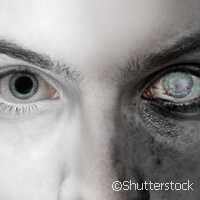Eye movements and schizophrenia
Scientists in the United Kingdom have discovered that simple viewing tests can detect impaired eye movements that can discriminate schizophrenia cases from healthy control subjects with over 98 % accuracy. Their model was presented in the journal Biological Psychiatry. Past studies linked impaired eye movements with schizophrenia. Said lead authors Drs Philip Benson and David St Clair of the University of Aberdeen in the United Kingdom: 'It has been known for over a hundred years that individuals with psychotic illnesses have a variety of eye movement abnormalities, but until our study, using a novel battery of tests, no one thought the abnormalities were sensitive enough to be used as potential clinical diagnostic biomarkers.' Smooth pursuit, free-viewing and gaze fixation tasks were included in the series of tests. With respect to smooth pursuit, patients with schizophrenia lack the ability to track slow-moving objects smoothly with their eyes. What happens is that their eye movements usually fall behind the object in motion, and they use fast eye movement to catch up with the object. Experts call this rapid eye movement a saccade. The free-viewing test focuses on image display. Here, most individuals follow a typical pattern with their gaze as they scan the picture, but individuals with schizophrenia follow an abnormal pattern. For the gaze fixation task, the subjects had to maintain a steady gaze on a single unmoving target. The control subjects did not miss a beat, while the subjects with schizophrenia had difficulty with this task. In this study, the researchers observed that the performance of subjects with schizophrenia was abnormal compared with the performance of healthy control subjects. The team then modelled the data and tested the accuracy of each algorithm through a battery of eye tests. The data obtained from the tests showed an accuracy rate of 98.3 %. 'It is encouraging to see the high sensitivity of this model for the diagnosis of schizophrenia,' commented Dr John Krystal, editor of Biological Psychiatry. 'It will be interesting to see the extent to which this approach enables clinical investigators to distinguish people with schizophrenia from individuals with other psychiatric disorders.' Drs Benson and St Clair have already begun working on this: 'We now have exciting unpublished data showing that patterns of eye movement abnormalities are specific to different psychiatric subgroups, another key requirement for diagnostic biomarkers. The next thing we want to know is when the abnormalities are first detectable and can they be used as disease markers for early intervention studies in major mental illness? We are also keen to explore how best our findings can be developed for use in routine clinical practice.'For more information, please visit:University of Aberdeen:http://www.abdn.ac.uk/Biological Psychiatry:http://www.journals.elsevier.com/biological-psychiatry/
Countries
United Kingdom



